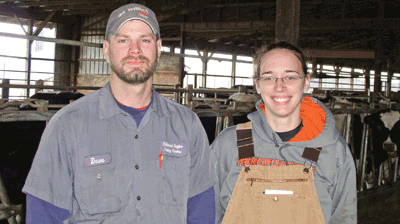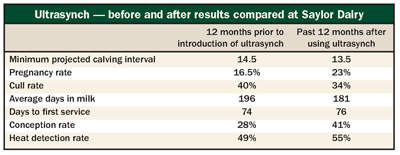The author is part owner of the White Oak Veterinary Clinic in Berlin, Pa.

Improved preg rates has been just one positive result of using ultrasynch,
reports Dave Stanton of Saylor Dairy (left) and Stevie Braun of COBA Select Sires (right).
In September 2009, Jessica McArt of Cornell University presented a research paper at the AABP (American Association of Bovine Practitioners) Conference on the use of "ultrasynch" as an aid in managing reproduction in dairy cattle. Ultrasynch is a synchronization program based on administering prostaglandins utilizing the measured size of the corpus luteum (CL). In the research project, she compared the results of rebreeding cattle using ovsynch versus ultrasynch.
In the study, open animals were assigned to either the ovsynch or the ultrasynch protocol. In ultrasynch, the cows were examined with ultrasonography for pregnancy at Days 28 to 34, and open cattle are given an injection of prostaglandin if the corpus luteum is 23 mm in diameter or greater. Because most cows have an approximate 21-day interval between heats, the cows checked open in the 28- to 34-day window should be 7 to 14 days past heat and have a functional CL that should respond to a PG injection. Using ultrasynch, only cattle exhibiting heat are bred. In the study, cattle enrolled in ovsynch and ultrasynch had similar results.
Concurrently, without knowledge that the previously mentioned research project was taking place at Cornell, Hillcrest Saylor Dairy, a 600-plus cow herd in Rockwood, Pa., embarked on a program almost identical to ultrasynch because of a series of events. The herdsman, David Stanton, had become disillusioned with ovsynch and CIDR-synch and had decided to place more emphasis on heat detection. At the same time, the farm enlisted the reproductive services of a clinic providing ultrasonography examinations.
Prior to March 2008, pregnancy examination was performed by palpation at 35 to 42 days, and open cows were given prostaglandin based on presence of palpable CL. Since March 2008, cows have been pregnancy checked weekly using ultrasound to check cows between 29 and 36 days postbreeding. The results of the management change have been impressive.
According to the herd computer herd records (PC Dart) generated March 2008, there were 640 cows in the herd; 313 were pregnant (49 percent). The average days in milk was 196 days. The nine-month pregnancy rate was 16.5 percent, and the projected calving interval was 14.5 months.
In October 2009, the projected calving interval was 13.5 months, the percent pregnant was 56 percent with an average day in milk for the herd at 181. The present pregnancy rate is 23 percent as calculated using PC Dart software.
Dave Stanton, the herd manager, says that several factors were involved in the improvement, "Using the ultrasound provides more definitive information about the size of the CL, and cows could be checked a week earlier with the ultrasound than by palpation." Stanton also noted that other management issues affect reproduction, "Good footing, cow comfort, and overall good herd health helped contribute to the improvement in reproduction in the last year. But," he noted, "heat detection is still the driver."
Stevie Braun, the main technician for this herd, who works for COBA Select Sires, observes the herd for heats twice daily, does all tail chalking, and breeds the cows. Braun noted progress in the herd, "I've become more of a fan of ultrasound since we have better information about the CLs and that has reduced the intervals between breeding and improved the chances of a cow showing heats after being given prostaglandins."
Ultrasynch has one major drawback; it requires that the herd be in a weekly herd check schedule since cows are to be checked at 28 to 34 days postbreeding or at seven weeks postprostaglandin injection. Some may question the expense of the extra ultrasounds. Because the cows are sorted and tied in headlocks in the various pens, and information is well organized, the cost of ultrasonography, including call fees, professional fees, and machine fee, averages less than $3 per exam.
In this herd, cull rate has been reduced significantly over the same period. Although ultrasynch is not the sole reason, it undoubtedly contributed to the decline. While this was not a controlled study, it demonstrates that the ultrasynch program can be an effective tool in managing reproduction. It proves that, for this herd, it is possible to have sustained acceptable reproductive performance without use of more involved programs resulting in improved heat detection, improved conception rate, and a reduction in average days in milk.

Click here to return to the Reproduction E-Sources
101025_702

reports Dave Stanton of Saylor Dairy (left) and Stevie Braun of COBA Select Sires (right).
In September 2009, Jessica McArt of Cornell University presented a research paper at the AABP (American Association of Bovine Practitioners) Conference on the use of "ultrasynch" as an aid in managing reproduction in dairy cattle. Ultrasynch is a synchronization program based on administering prostaglandins utilizing the measured size of the corpus luteum (CL). In the research project, she compared the results of rebreeding cattle using ovsynch versus ultrasynch.
In the study, open animals were assigned to either the ovsynch or the ultrasynch protocol. In ultrasynch, the cows were examined with ultrasonography for pregnancy at Days 28 to 34, and open cattle are given an injection of prostaglandin if the corpus luteum is 23 mm in diameter or greater. Because most cows have an approximate 21-day interval between heats, the cows checked open in the 28- to 34-day window should be 7 to 14 days past heat and have a functional CL that should respond to a PG injection. Using ultrasynch, only cattle exhibiting heat are bred. In the study, cattle enrolled in ovsynch and ultrasynch had similar results.
Concurrently, without knowledge that the previously mentioned research project was taking place at Cornell, Hillcrest Saylor Dairy, a 600-plus cow herd in Rockwood, Pa., embarked on a program almost identical to ultrasynch because of a series of events. The herdsman, David Stanton, had become disillusioned with ovsynch and CIDR-synch and had decided to place more emphasis on heat detection. At the same time, the farm enlisted the reproductive services of a clinic providing ultrasonography examinations.
Prior to March 2008, pregnancy examination was performed by palpation at 35 to 42 days, and open cows were given prostaglandin based on presence of palpable CL. Since March 2008, cows have been pregnancy checked weekly using ultrasound to check cows between 29 and 36 days postbreeding. The results of the management change have been impressive.
According to the herd computer herd records (PC Dart) generated March 2008, there were 640 cows in the herd; 313 were pregnant (49 percent). The average days in milk was 196 days. The nine-month pregnancy rate was 16.5 percent, and the projected calving interval was 14.5 months.
In October 2009, the projected calving interval was 13.5 months, the percent pregnant was 56 percent with an average day in milk for the herd at 181. The present pregnancy rate is 23 percent as calculated using PC Dart software.
Dave Stanton, the herd manager, says that several factors were involved in the improvement, "Using the ultrasound provides more definitive information about the size of the CL, and cows could be checked a week earlier with the ultrasound than by palpation." Stanton also noted that other management issues affect reproduction, "Good footing, cow comfort, and overall good herd health helped contribute to the improvement in reproduction in the last year. But," he noted, "heat detection is still the driver."
Stevie Braun, the main technician for this herd, who works for COBA Select Sires, observes the herd for heats twice daily, does all tail chalking, and breeds the cows. Braun noted progress in the herd, "I've become more of a fan of ultrasound since we have better information about the CLs and that has reduced the intervals between breeding and improved the chances of a cow showing heats after being given prostaglandins."
Ultrasynch has one major drawback; it requires that the herd be in a weekly herd check schedule since cows are to be checked at 28 to 34 days postbreeding or at seven weeks postprostaglandin injection. Some may question the expense of the extra ultrasounds. Because the cows are sorted and tied in headlocks in the various pens, and information is well organized, the cost of ultrasonography, including call fees, professional fees, and machine fee, averages less than $3 per exam.
In this herd, cull rate has been reduced significantly over the same period. Although ultrasynch is not the sole reason, it undoubtedly contributed to the decline. While this was not a controlled study, it demonstrates that the ultrasynch program can be an effective tool in managing reproduction. It proves that, for this herd, it is possible to have sustained acceptable reproductive performance without use of more involved programs resulting in improved heat detection, improved conception rate, and a reduction in average days in milk.

101025_702








